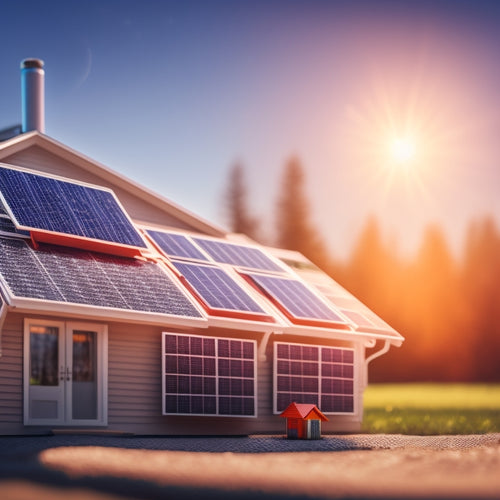
3 Best Solar Batteries for Home Systems
Share
When selecting the best solar battery for your home system, consider three top options: the Tesla Powerwall, LG Chem RESU, and Sonnen eco. Each offers reliable energy storage and independence from the grid. The Tesla Powerwall boasts a high cycle life rating of 5,000-7,000 cycles, while the LG Chem RESU provides a modular design for flexible energy storage. The Sonnen eco, with its advanced lithium-ion chemistry, supports up to 10,000 cycles. By understanding your daily energy usage patterns and depth of discharge needs, you'll be able to choose the right solar battery for your home system, and as you investigate further, you'll uncover the perfect fit for your energy independence goals.
At a Glance
- When selecting a solar battery for home systems, consider the Depth of Discharge (DOD) to balance energy needs with battery capacity and lifespan.
- Look for lithium-ion batteries that offer high cycle life ratings (up to 5,000 cycles) for reliable power and reduced maintenance costs.
- Integration with smart appliances and energy efficiency upgrades can maximize savings and optimize energy consumption.
- Understanding daily energy usage patterns helps in choosing the right battery size and optimizing solar battery efficiency.
- A higher cycle life rating directly links to longer battery lifespan, reducing the frequency of replacements and maintenance costs.
Reduce Grid Dependence Now
You're taking the first step towards energy independence by investing in a solar battery system, and that's an essential move towards reducing your reliance on the grid.
With a Home Solar Battery, you can shield yourself from fluctuating grid prices and reduce your energy bills.
Energy Independence Now
Reducing grid dependence is an essential step towards energy independence, and it starts with utilizing the power of solar energy. By utilizing renewable energy from the sun, you're taking control of your energy needs and reducing your reliance on the grid.
This is where energy storage comes in – with a reliable solar battery, you can store excess energy generated during the day for use during the night or during power outages. With the ability to integrate home renewable energy systems into your daily life, you can seamlessly switch between grid power and solar power, ensuring a stable and efficient energy supply.
This means you'll be protected from grid outages and rate hikes, giving you peace of mind and financial freedom. By investing in a high-quality solar battery, you're investing in your energy independence.
As you move towards energy independence, you'll enjoy the benefits of reduced energy bills, increased property value, and a reduced carbon footprint.
You'll be joining a community of like-minded individuals who value freedom and self-sufficiency. With the right solar battery, you'll be well on your way to achieving energy independence – and enjoying the many benefits that come with it.
Grid Free Living
The sun's daily rhythm dictates your energy usage no more; with a reliable solar battery, you can break free from the grid's constraints. You're no longer bound by the limitations of traditional power sources, and you can finally experience the freedom that comes with grid-free living.
By integrating solar panels with a high-capacity battery, you can store excess energy generated during the day for use at night or during periods of low sunlight. This means you can power your home, even when the grid is down. With a well-designed Residential Energy Storage System Renewable Energy, you can optimize your energy consumption and reduce your reliance on the grid. By leveraging the power of solar energy and battery storage, you can enjoy a more sustainable living experience.
To maintain your newfound independence, regular battery maintenance is essential. This includes monitoring the battery's state of charge, guaranteeing proper ventilation, and performing routine software updates.
Lower Your Energy Bills
By integrating a solar battery into your home system, you'll be able to identify and cut energy waste now, reducing the overall power consumption in your home.
With the help of affordable energy storage solutions like Tesla Powerwall, you can optimize your energy usage and maximize your savings. This results in significant savings on your energy bills, as you'll be utilizing the free energy generated by your solar panels during the day.
Cut Energy Waste Now
You're likely no stranger to the frustration of watching your hard-earned money disappear into thin air, courtesy of inefficient energy usage. It's a bitter pill to swallow, especially when you consider that a significant portion of your energy bill is wasted on standby power, outdated appliances, and inefficient lighting. However, by cutting energy waste, you can regain control over your energy consumption and lower your bills.
Here's a breakdown of the most common energy-wasting culprits and their solutions:
| Energy-Wasting Culprit | Solution |
|---|---|
| Standby power | Unplug appliances when not in use or use power strips |
| Outdated appliances | Replace with energy-efficient alternatives |
| Inefficient lighting | Switch to LED bulbs |
| Poor insulation | Add insulation to your attic and walls |
| Leaky ducts | Seal and insulate your ducts |
Reduce Power Consumption
Reduce Power Consumption (Lower Your Energy Bills)
Cutting energy waste is just the first step; optimizing your power consumption is where the real savings happen. You've already taken the vital step of identifying and eliminating energy vampires, but now it's time to take it to the next level.
By focusing on energy efficiency, you can remarkably lower your energy bills and maximize your solar battery's potential.
Start by upgrading to smart appliances that are designed with energy efficiency in mind. These appliances use advanced technology to optimize their energy consumption, guaranteeing that they only use what they need.
For example, smart refrigerators can adjust their cooling cycles based on your usage patterns, reducing energy waste and saving you money.
Next, take a closer look at your lighting system. Replace traditional incandescent bulbs with LEDs, which use remarkably less energy and last longer.
You can also install occupancy sensors and timers to guarantee that lights are only on when needed.
Depth of Discharge Matters
When you're selecting a solar battery for your home system, you'll want to contemplate the depth of discharge (DOD) - the percentage of the battery's capacity that's used daily.
For instance, a residential solar battery system that's designed for home energy independence should be chosen carefully. A higher DOD can reduce the battery's cycle life, impacting its overall lifespan.
Your daily usage patterns will influence the ideal DOD, so it's crucial to understand how these factors intersect.
Cycle Life Impact
As you investigate the world of solar batteries, it's vital to grasp the concept of cycle life impact, which hinges on the depth of discharge (DOD).
When you understand how DOD affects your battery's lifespan, you'll make more informed decisions about battery maintenance and cost considerations. A battery's cycle life is the number of charge/discharge cycles it can handle before its capacity drops below 80%.
If you consistently discharge your battery to 80% DOD, it'll last longer than if you frequently drain it to 50%. This is because deeper discharges put more stress on the battery, reducing its overall lifespan.
To maximize your battery's cycle life, it's important to balance your energy needs with the battery's capacity. Avoiding deep discharges through smart battery management can greatly extend its lifespan.
Additionally, choosing a battery with a higher cycle life rating can provide more flexibility in your energy usage. By considering cycle life impact, you'll be able to strike a balance between your energy needs and the longevity of your solar battery system, ultimately saving you money and hassle in the long run.
Daily Usage Patterns
In conjunction with your solar panel system, your daily energy usage patterns play a significant role in determining the depth of discharge (DOD) of your solar battery. Your battery's DOD is critical because it directly affects its lifespan and overall performance. Understanding your daily usage patterns helps you optimize your energy consumption, reducing peak energy usage and maximizing off-peak savings.
| Time of Day | Energy Usage |
|---|---|
| Morning (6am-10am) | High (lights, appliances, heating/cooling) |
| Day (10am-4pm) | Medium (lights, appliances, partial heating/cooling) |
| Evening (4pm-10pm) | High (lights, appliances, heating/cooling, entertainment) |
| Night (10pm-6am) | Low (minimal lighting, appliances) |
| Peak Hours | High (energy-intensive activities like laundry, cooking) |
Cycle Life Rating Matters
You've already considered the importance of depth of discharge when selecting a solar battery for your home system.
Now, it's vital to look at the cycle life rating, which represents the lifespan of the battery in cycles.
With top home battery systems like Tesla Powerwall and LG Chem RESU, it's important to evaluate their performance in providing reliable backup power for homes during outages and emergencies residential power storage.
A higher cycle life rating indicates a longer lifespan, making it a significant factor in determining the overall value of your investment.
Depth of Discharge Matters
Depth of discharge (DOD) greatly impacts the lifespan of your solar battery. You need to understand how DOD affects your battery's performance and longevity. DOD refers to the percentage of a battery's capacity that's used before it's recharged. A higher DOD means you're using more of your battery's capacity, which can reduce its lifespan.
Here's a breakdown of how DOD affects your solar battery:
| DOD | Cycle Life | Discharge Implications |
|---|---|---|
| 50% | 5,000-7,000 | Moderate usage, balanced lifespan and capacity |
| 70% | 3,000-5,000 | Higher usage, reduced lifespan, increased maintenance |
| 80% | 2,000-3,000 | Aggressive usage, considerably reduced lifespan, frequent replacement |
| 90% | 1,000-2,000 | Extreme usage, severely reduced lifespan, high maintenance costs |
| 100% | 500-1,000 | Avoid at all costs, drastic reduction in lifespan and capacity |
When considering depth of discharge, you need to weigh the benefits of using more of your battery's capacity against the potential risks of reducing its lifespan. A deeper DOD may provide more power, but it can also lead to more frequent replacements and higher maintenance costs.
Lifespan in Cycles
Beyond the subtleties of depth of discharge, another critical factor in evaluating solar batteries is their lifespan in cycles, which is often represented by a cycle life rating. You want to know how many times your battery can charge and discharge before its capacity starts to degrade. This is where the cycle life rating comes in. A higher rating means your battery will last longer and provide more consistent performance over time.
When considering cycle life, you should also think about battery chemistry. Different chemistries have varying levels of cycle longevity. For example, lithium-ion batteries are known for their high cycle life, with some models rated for up to 5,000 cycles. On the other hand, lead-acid batteries typically have a lower cycle life rating.
When evaluating solar batteries, look for a high cycle life rating to guarantee your system will provide reliable power for years to come. A longer cycle life means fewer replacements and lower maintenance costs, giving you more freedom to enjoy the benefits of your solar power system.
Lithium-Ion Beats Lead-Acid
You'll find that lithium-ion batteries outperform lead-acid batteries with regard to cycle life, with some models offering up to 5,000 cycles or more.
In contrast, lead-acid batteries typically top out at around 1,000 to 2,000 cycles, depending on the specific model and usage.
This significant difference in cycle life means lithium-ion batteries will provide you with a much longer lifespan and reduced replacement costs over time.
Longer Cycle Life
A crucial factor in evaluating solar batteries for home systems is their cycle life, which refers to the number of charge/discharge cycles a battery can support before its capacity degrades. You want a battery that can withstand the daily charge and discharge cycles without losing its capacity quickly. Lithium-ion batteries outshine lead-acid batteries in this aspect.
| Battery Type | Cycle Life | Maintenance Tips |
|---|---|---|
| Lithium-Ion | 3,000 - 5,000 | Monitor temperature, avoid deep discharging |
| Lead-Acid | 1,000 - 3,000 | Check electrolyte levels, avoid overcharging |
| Lithium-Iron Phosphate | 2,000 - 4,000 | Avoid extreme temperatures, monitor state of charge |
| Flow Batteries | 4,000 - 6,000 | Monitor electrolyte levels, perform regular cleaning |
Lithium-ion batteries have a longer cycle life due to their advanced battery chemistry. This means you can charge and discharge them more times before their capacity drops. In contrast, lead-acid batteries have a shorter cycle life, requiring more maintenance and replacement. By choosing a lithium-ion battery, you'll enjoy a longer-lasting and more reliable energy storage system, giving you the freedom to power your home without worrying about battery degradation.
Frequently Asked Questions
Can I Use Solar Batteries With an Existing Grid-Tied Solar System?
You can retrofit a solar battery to your existing grid-tied system, enjoying solar battery integration benefits like backup power and reduced grid reliance, while still utilizing grid-tied benefits like net metering and utility credits.
Are Solar Batteries Compatible With All Types of Solar Panels?
You'll find that solar batteries are compatible with most solar panel types, but their performance may vary depending on the panel's voltage and current output, as well as the battery chemistry, such as lithium-ion or lead-acid, you're using.
How Long Does It Take to Fully Charge a Solar Battery?
As you capture the sun's power, you're left wondering how long it takes to fully charge your solar battery. The answer lies in the battery capacity, with charging time varying from 2-10 hours, depending on the capacity, from 2 kWh to 10 kWh, and the power input from your solar array.
Can I Add More Batteries to My System in the Future?
You can easily scale up your system's battery capacity by adding more batteries in the future, ensuring flexibility for future expansion and increased energy independence, without worrying about compatibility or installation hassles.
Are Solar Batteries Safe From Thermal Runaway and Fires?
You invest in solar batteries that prioritize thermal management, using advanced battery materials that minimize thermal runaway risks, ensuring your freedom from fires and electrical hazards, and giving you peace of mind with every sunny day.
Explore More
By investing in a high-quality solar battery, you'll reduce your grid dependence and lower your energy bills. Consider a battery with a high depth of discharge and cycle life rating, like lithium-ion options. For instance, a California homeowner who installed a 10kWh lithium-ion battery saw a 90% reduction in their grid energy consumption, saving them over $1,000 annually. With the right solar battery, you can access the full potential of your renewable energy system and start reaping the financial benefits.
Related Posts
-

A Beginner's Guide to Navigating the Solar Investment Tax Credit
You're eligible to claim a significant Solar Investment Tax Credit (ITC) of 30% of total installation costs, but mane...
-

Top-Rated Home Solar Power Kits for Achieving Energy Independence
Top-rated home solar power kits enable you to achieve energy independence by greatly cutting your energy costs. You c...
-

Smart Grid Technology Implementation Challenges
You'll encounter several challenges when implementing smart grid technology, particularly in cost management, scalabi...


